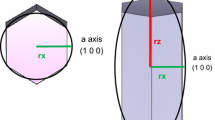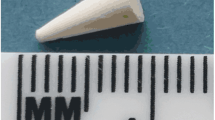Abstract
An extension of the application of calcium phosphate cements (CPC) to load-bearing defects, e.g. in vertebroplasty, would require less brittle cements with an increased fracture toughness. Here we report the modification of CPC made of alpha-tricalcium phosphate (α-TCP) with 2-hydroxyethylmethacrylate (HEMA), which is polymerised during setting to obtain a mechanically stable polymer-ceramic composite with interpenetrating organic and inorganic networks. The cement liquid was modified by the addition of 30–70 % HEMA and ammoniumpersulfate/tetramethylethylendiamine as initiator. Modification of α-TCP cement paste with HEMA decreased the setting time from 14 min to 3–8 min depending on the initiator concentration. The 4-point bending strength was increased from 9 MPa to more than 14 MPa when using 50 % HEMA, while the bending modulus decreased from 18 GPa to approx. 4 GPa. The addition of ≥50 % HEMA reduced the brittle fracture behaviour of the cements and resulted in an increase of the work of fracture by more than an order of magnitude. X-ray diffraction analyses revealed that the degree of transformation of α-TCP to calcium deficient hydroxyapatite was lower for polymer modified cements (82 % for polymer free cement and 55 % for 70 % HEMA) after 24 h setting, while the polymerisation of HEMA in the cement liquid was quantitative according to FT-IR spectroscopy. This work demonstrated the feasibility of producing fracture resistant dual-setting calcium phosphate cements by adding water soluble polymerisable monomers to the liquid cement phase, which may be suitable for an application in load-bearing bone defects.









Similar content being viewed by others
References
Breusch SJ, Kuhn KD. Bone cements based on polymethylmethacrylate. Orthopäde. 2003;32(1):41–50.
Dorozhkin SV. Calcium orthophosphate cements for biomedical application. J Mater Sci. 2008;43(9):3028–57.
Jaeblon T. Polymethylmethacrylate: properties and contemporary uses in orthopaedics. J Am Acad Orthop Surg. 2010;18(5):297–305.
Heini PF. Vertebroplastie: ein update. Orthopäde. 2010;39(7):658–64.
Stanczyk M, van Rietbergen B. Thermal analysis of bone cement polymerisation at the cement-bone interface. J Biomech. 2004;37(12):1803–10.
Bettencourt A, Calado A, Amaral J, Vale FM, Rico JMT, Monteiro J, Lopes A, Pereira L, Castro M. In vitro release studies of methylmethacrylate liberation from acrylic cement powder. Int J Pharm. 2000;197(1):161–8.
Theiss F, Apelt D, Brand BA, Kutter A, Zlinszky K, Bohner M, Matter S, Frei C, Auer JA, von Rechenberg B. Biocompatibility and resorption of a brushite calcium phosphate cement. Biomaterials. 2005;26(21):4383–94.
Bohner M, Gbureck U, Barralet JE. Technological issues for the developement of more efficient calcium phosphate bone cements: a critical assessment. Biomaterials. 2005;26(33):6423–9.
Canal C, Ginebra MP. Fibre-reinforced calcium phosphate cements: a review. J Mech Behav Biomed. 2011;4(8):1658–71.
Khairoun I, Driessens FCM, Boltong MG, Planell JA, Wenz R. Addition of cohesion promoters to calcium phosphate cements. Biomaterials. 1999;20(4):393–8.
Alkhraisat MH, Rueda C, Marino FT, Torres J, Jerez LB, Gbureck U, Cabarcos EL. The effect of hyaluronic acid on brushite cement cohesion. Acta Biomaterialia. 2009;5(8):3150–6.
Moreau JL, Weir MD, Xu HHK. Self-setting collagen-calcium phosphate bone cement: mechanical and cellular properties. J Biomed mater Res. 2009;91A(2):605–13.
Schneiders W, Reinstorf A, Biewener A, Serra A, Grass R, Kinscher M, Heineck J, Rehberg S, Zwipp H, Rammelt S. In vivo effects of modification of hydroxyapatite/collagen composites with and without chondroitin sulphate on bone remodeling in the sheep tibia. J Orthop Res. 2009;27(1):15–21.
Tamimi F, Kumarasami B, Doillon C, Gbureck U, Le Nihouannen D, Lopez Cabarcos E, Barralet JE. Brushite–collagen composites for bone regeneration. Acta Biomater. 2008;4(5):1315–21.
dos Santos LA, Carrodeguas RG, Boschi AO, de Arruda ACF. Fiber-enriched double-setting calcium phosphate bone cement. J Biomed Mater Res A. 2003;65A(2):244–50.
dos Santos LA, Carrodeguas RG, Boschi AO, de Arruda ACF. Dual-setting calcium phosphate cement modified with ammonium polyacrylate. Artif Organs. 2003;27(5):412–8.
Wang J, Liu C, Liu Y, Zhang S. Double-network interpenetrating bone cement via in situ hybridization protocol. Adv Funct Mater. 2010;20(22):3997–4011.
Filmon R, Grizon F, Baslé MF, Chappard D. Effects of negatively charged groups (carboxymethyl) on the calcification of poly(2-hydroxyethyl methacrylate). Biomaterials. 2002;23(14):3053–9.
Song J, Malathong V, Bertozzi CR. Mineralization of synthetic polymer scaffolds: a bottom-up approach for the development of artificial bone. J Am Chem Soc. 2005;127(10):3366–72.
ASTM-Standard C266-99: standard test method for time of setting of hydraulic cement paste by Gilmore needles. ASTM International 2002.
Zainuddin, Hill DJT, Chirila TV, Whittaker AK, Kemp A. Experimental calcification of HEMA-based hydrogels in the presence of albumin and a comparison to the in vivo calcification. Biomacromolecules 2006;7(6):1758–65.
White CJ, Tieppo A, Byrne ME. Controlled drug release from contact lenses: a comprehensive. J Drud Deliv Sci Tec. 2011;21(5):369–84.
Montheard JP, Chatzopoulos M, Chappard D. 2-Hydroxyethyl methacrylate (HEMA)—chemical properties and applications in biomesical fields. J Macromol Sci Rev Macromol Chem Phys. 1992;C32(1):1–34.
Gkioni K, Leeuwenburgh SCG, Douglas TEL, Mikos AG, Jansen JA. Mineralisation of hydrogels for bone generation. Tissue Eng B. 2010;16(6):577–85.
Ginebra MP, Fernandez E, Driessens FCM, Planell JA. Modeling the hydrolysis of α-tricalcium phosphate. J Am Ceram Soc. 1999;82(10):2808–12.
Xu HHK, Quinn JB, Takagi S, Chow LC, Eichmiller FC. Strong and macroporous calcium phosphate cement: effects of porosity and fibre reinforcement. J Biomed Mater Res. 2001;57(3):457–66.
Xu HHK, Eichmiller FC, Giuseppetti AA. Reinforcement of a self-setting calcium phosphate cement with different fibres. J Biomed Mater Res. 2000;52(1):107–14.
Gorst NJS, Perrie Y, Gbureck U, Hutton AL, Hofmann MP, Grover LM, Barralet JE. Effects of fibre reinforcement on the mechanical properties of brushite cement. Acta Biomater. 2006;2(1):95–102.
Barralet JE, Gaunt T, Wright AJ, Gibson IR, Knowles JC. Effect of porosity reduction by compaction on compressive strength and microstructure of calcium phosphate cement. J Biomed Mater Res (Appl Biomater). 2002;63(1):1–9.
Ishikawa K, Asaoka K. Estimation of ideal mechanical strength and critical porosity of calcium phosphate cement. J Biomed Mater Res. 1995;29(12):1537–43.
Ginebra MP, Canal C, Espanol M, Pastorino D, Montufar EB. Calcium phosphate cements as drug delivery materials. Adv Drug Deliv Rev. 2012;64:1090–110.
Siepmann J, Peppas NA. Mathematical modelling of controlled drug delivery. Adv Drug Deliv Rev. 2001;48(2–3):137–8.
Ritger PL, Peppas NA. A simple equation for description of solute release I. Fickian and non-Fickian release from non-swellable devices in the form of slabs, spheres, cylinders or discs. J Control Release. 1987;5:23–36.
Kumar A, Tyagi P, Singh H, Kumar Y, Lahiri SS. Synthesis and characterization of a porous poly(hydroxyethylmethacrylate-co-ethylene glycol dimethacrylate)-based hydrogel device for the implantable delivery of insulin. J Appl Polym Sci. 2012;126:894–905.
Author information
Authors and Affiliations
Corresponding author
Rights and permissions
About this article
Cite this article
Christel, T., Kuhlmann, M., Vorndran, E. et al. Dual setting α-tricalcium phosphate cements. J Mater Sci: Mater Med 24, 573–581 (2013). https://doi.org/10.1007/s10856-012-4828-7
Received:
Accepted:
Published:
Issue Date:
DOI: https://doi.org/10.1007/s10856-012-4828-7




